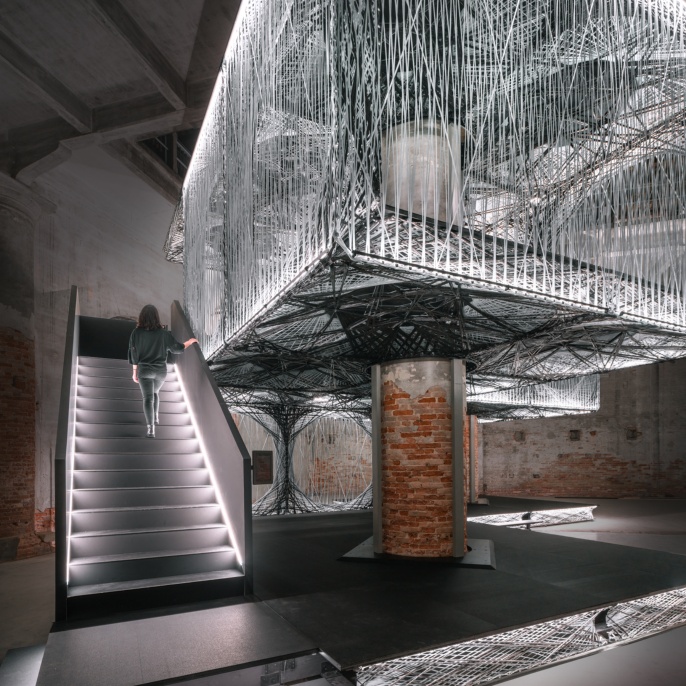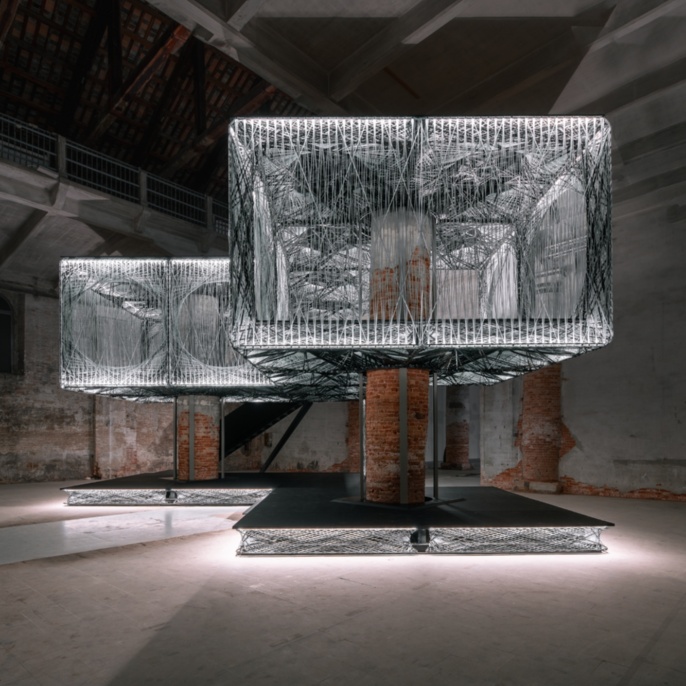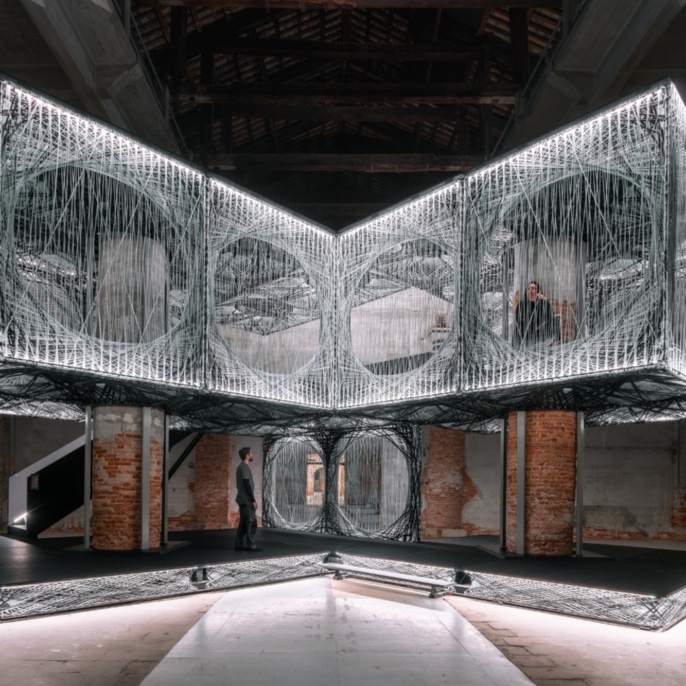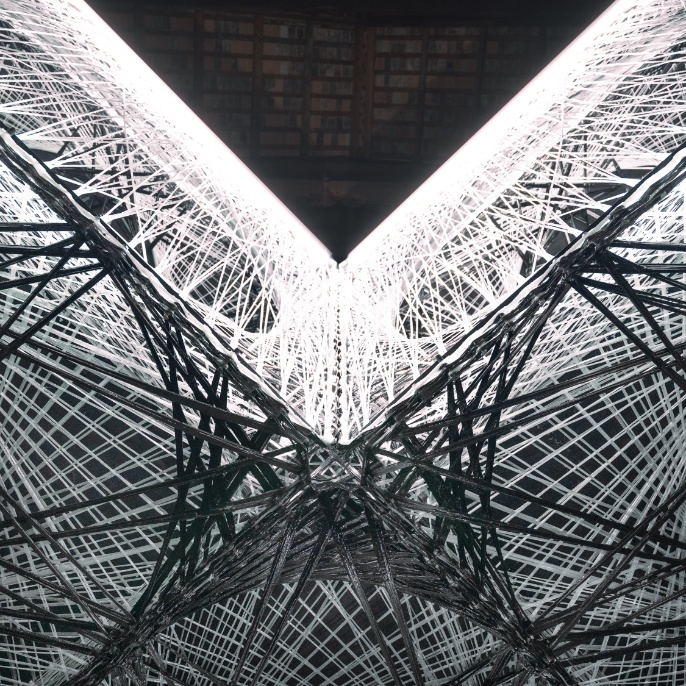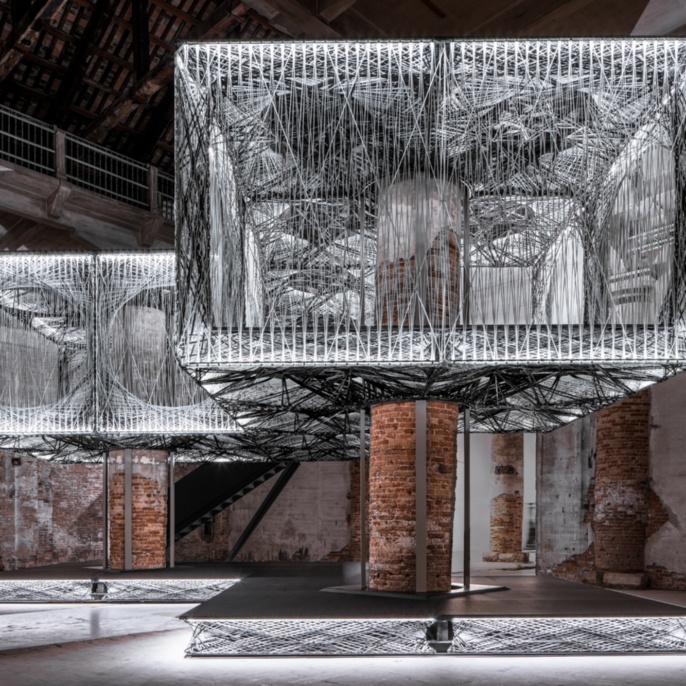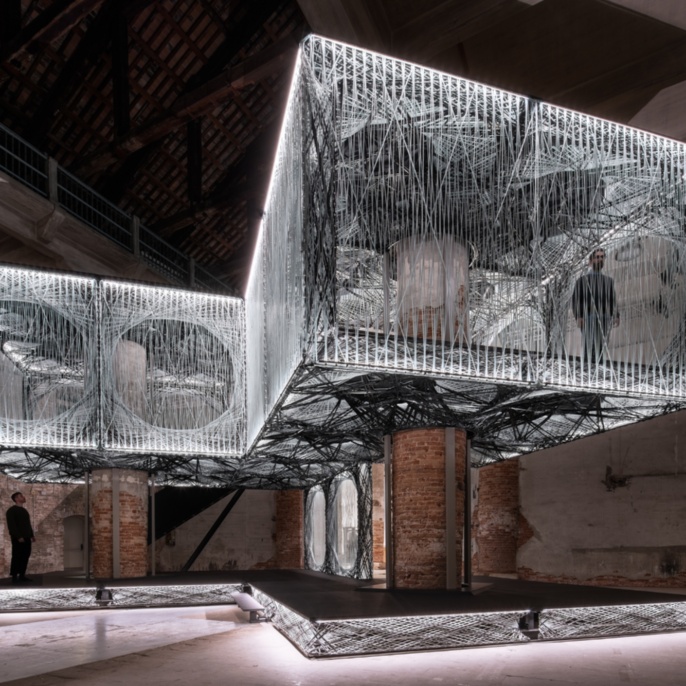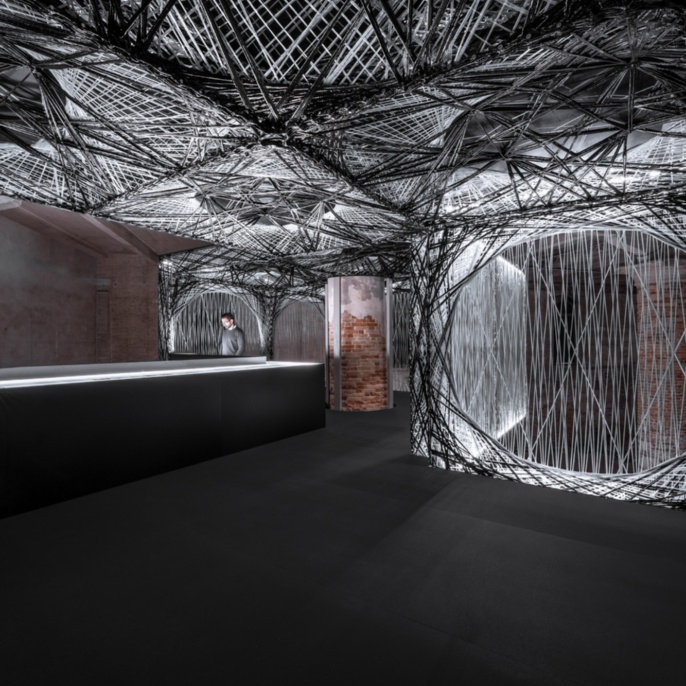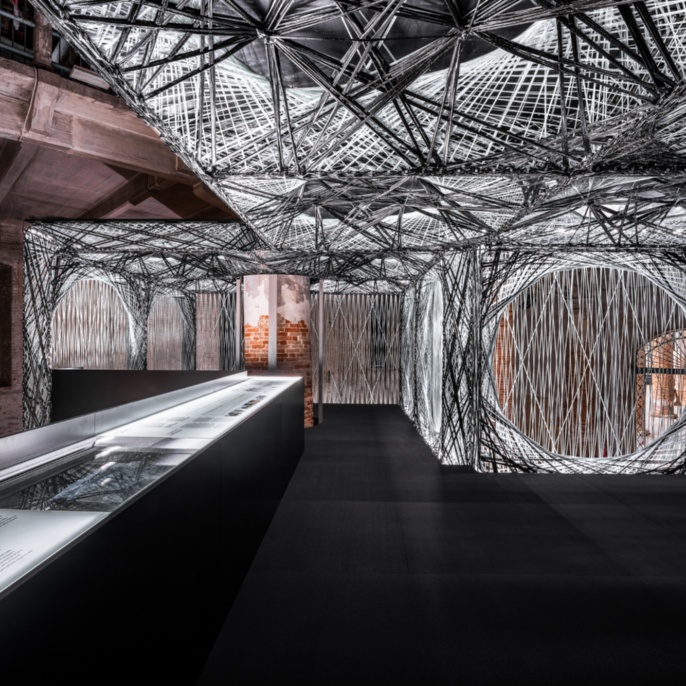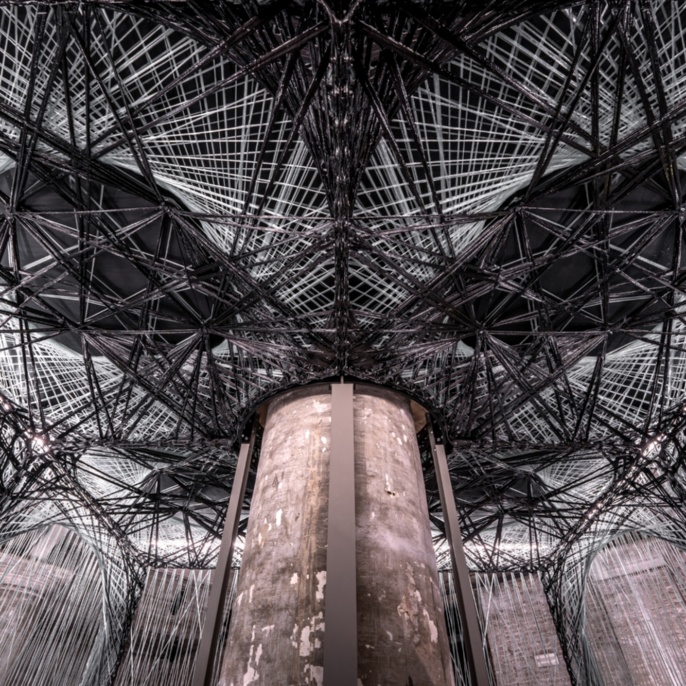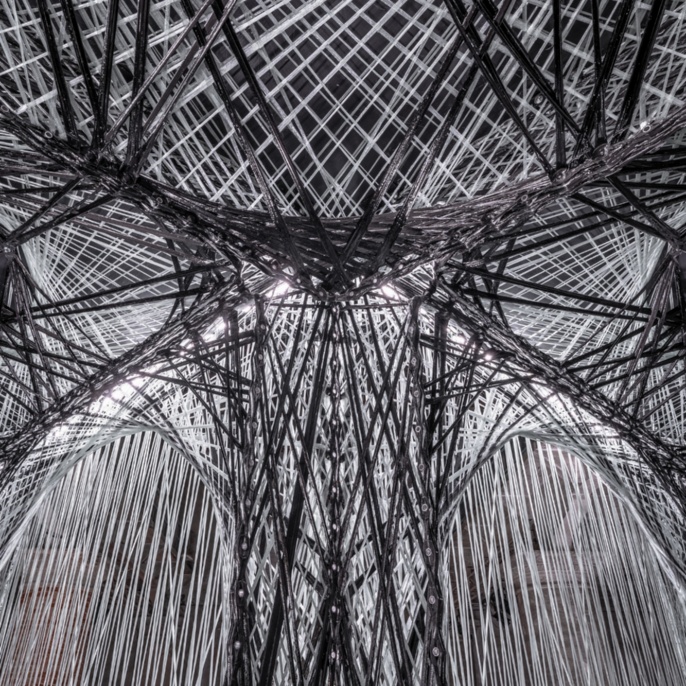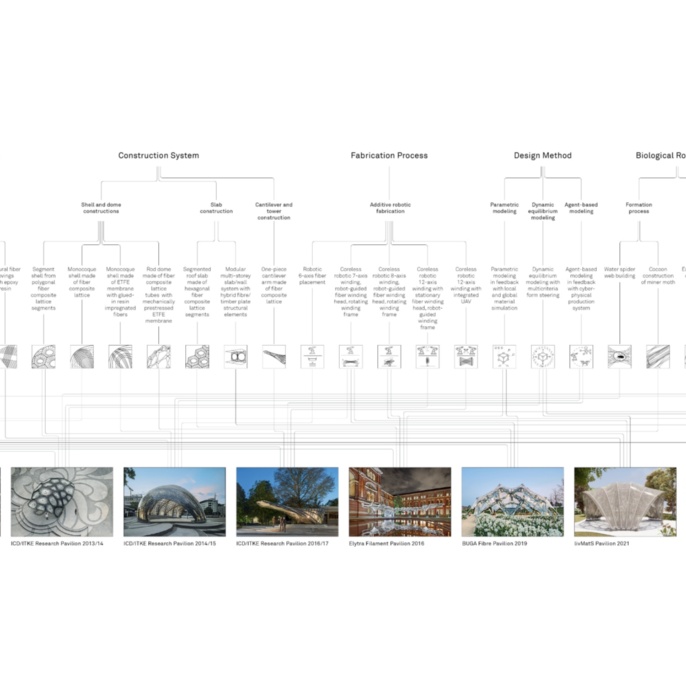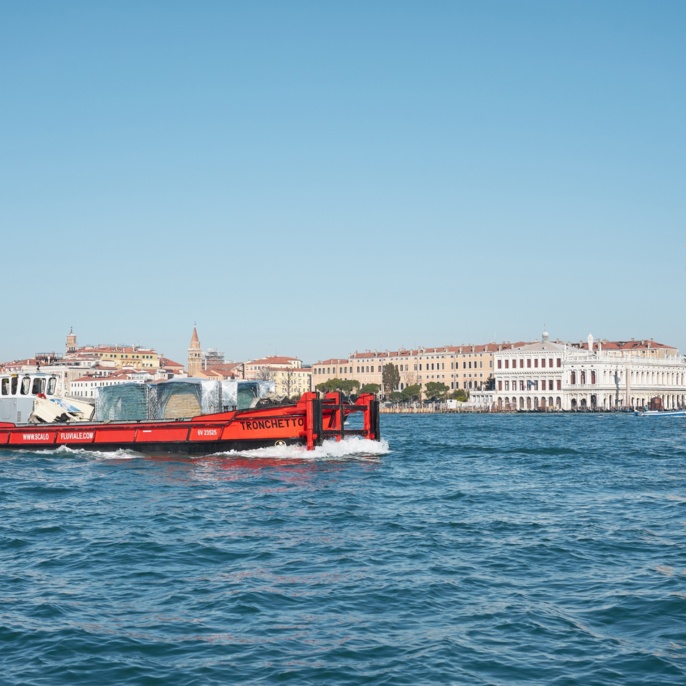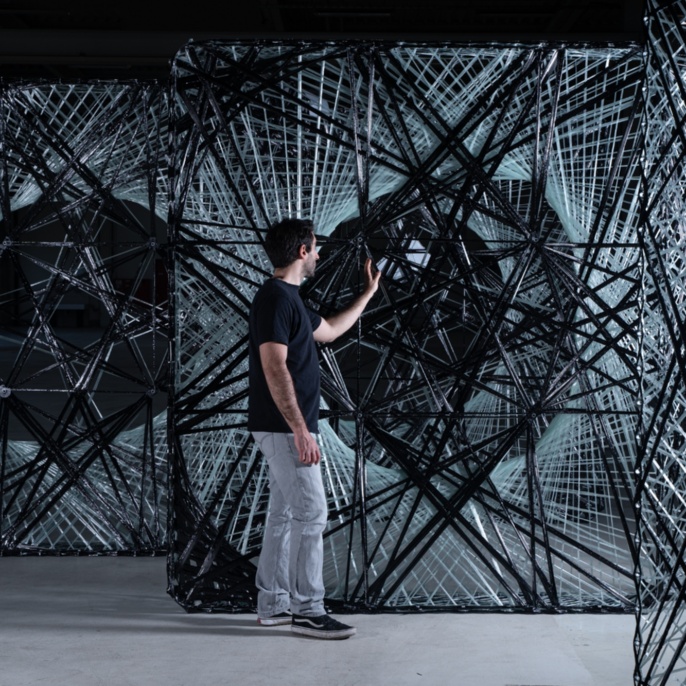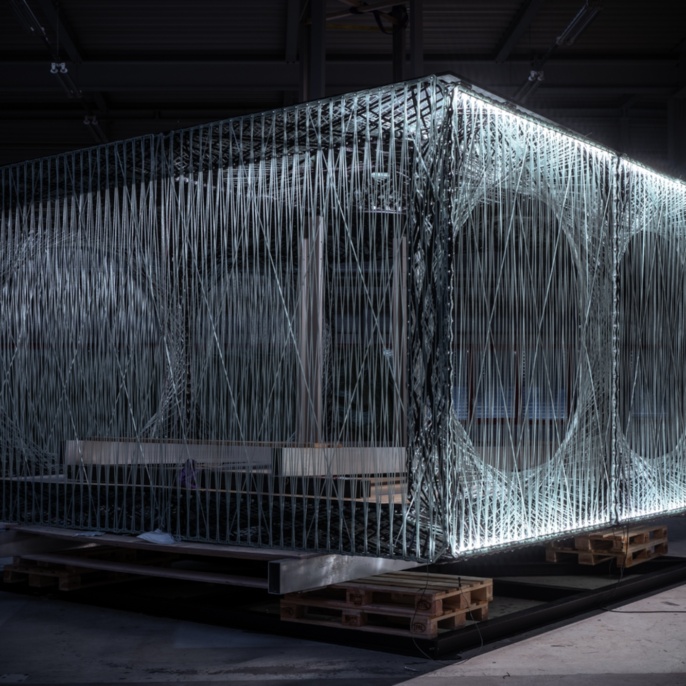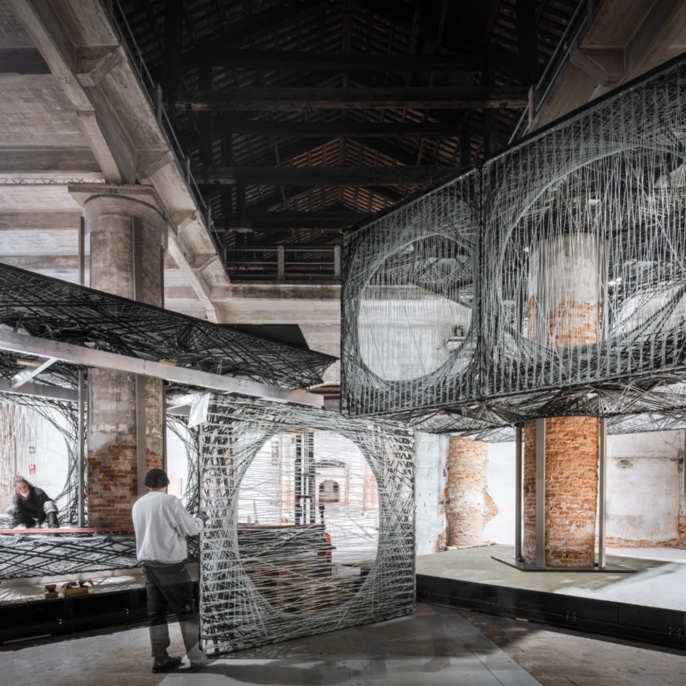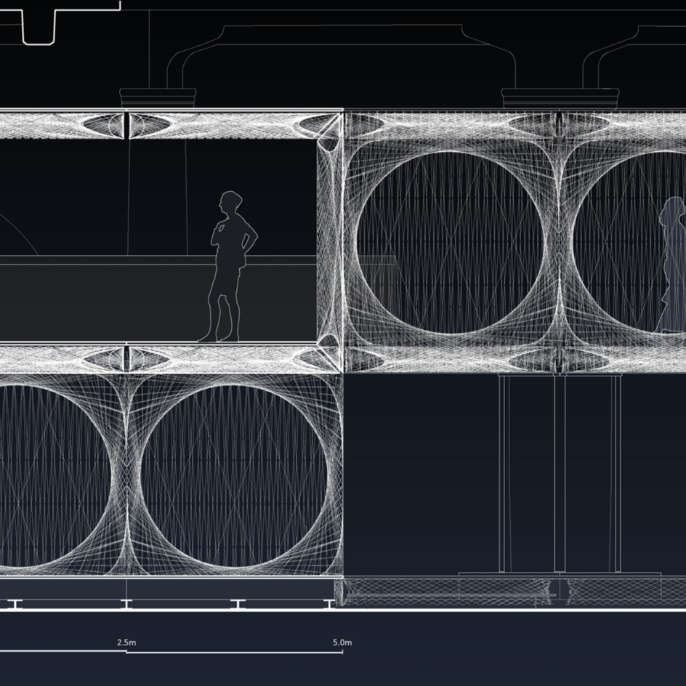Photographs by ICD/ITKE/IntCDC, University of Stuttgart
Development Process Images by ICD/ITKE/IntCDC, University of Stuttgart
Drawings of ICD/ITKE/IntCDC, University of Stuttgart
Maison Fibre, Biennale Architettura 2021
Towards a novel material culture
Maison Fibre, exhibited at the 17th International Architecture Exhibition – La Biennale di Venezia 2021, explores an alternative approach to the design and construction of future habitable spaces. In response to the exhibition theme “How will we live together?”, the Institute for Computational Design and Construction (ICD) and the Institute of Building Structures and Structural Design (ITKE) of the Cluster of Excellence IntCDC at the University of Stuttgart present a full-scale inhabitable installation made entirely from robotically produced, fibrous building elements, constituting the very first multi-story structure of its kind.
As the central display of their project on “Material Culture”, Maison Fibre offers visitors the intense material experience and spatial expression of future, highly dematerialized structures, where each building element can be locally made from just a few kilos of construction material. Compared to Le Corbusier’s Maison Dom-Ino as a role model for 20th century architecture, the weight footprint of Maison Fibre is reduced fiftyfold and points toward a novel material culture in architecture, as well as the related ecological (material and energy), economic (value chains and knowledge production), technical (digital technologies and robotics), and sociocultural matters entailed herein.
Rethinking the physical substrate for living together
We spend 87 percent of our lives in buildings. Buildings constitute the physical substrate for living together, and it is precisely this materiality and materialization of buildings that poses one of the most important ecological and social challenges to society. The question of how people will live together in the future is thus intrinsically linked to the question of the future of building.
Construction has become one of the most materially intense and environmentally detrimental human activities. The per capita consumption of construction materials for load-bearing structures alone, which account for more than half of the materials used in buildings, has multiplied over the last century. Building in the present form, which prioritizes simple construction processes over saving material and resources, no longer seems sustainable. New approaches are urgently needed.
Nature provides just such a paradigmatic alternative: Almost all load-bearing structures in biology are fibrous systems, in which the fiber organization, directionality, and density are finely calibrated with the occurring forces. The resulting high level of morphological differentiation, functionality, and related resource efficiency are emblematic of natural structures. The biomimetic principles of using “less material” by having “more form” have been investigated for many years by the project team at the University of Stuttgart. Fibrous construction offers a profoundly different material approach for building future human habitats.
Maison Fibre: Towards a material culture of dematerialisation
ICD and ITKE’s contribution to the Biennale Architettura 2021 is an exploration of an alternative material culture, a term commonly used in the social sciences and the humanities. Maison Fibre, the central display of the exhibition, is both a full-scale architectural installation and an open model for the cultural change being postulated. It deals with the departure from pre-digital, material-intensive construction using mostly heavy, isotropic building materials such as concrete, stone, and steel—which are often extracted in faraway places, processed into building elements, and then transported over long distances—to genuinely digital construction methods with locally differentiated and locally manufactured structures made of highly anisotropic materials: an architecture made of fibers.
Maison Fibre is based on a decade of research on robotically manufactured fiber composite structures. It is the first multi-story architecture of this kind, featuring inhabitable fibrous floor slabs and walls. The entire structure consists exclusively of so-called fiber rovings, essentially bundles of endless, unidirectional fibers. To underline the model character of the project, a system of reconfigurable wall and ceiling elements based on the 2.5-meter grid dimension typical of residential buildings was developed.
The project's projective aspect is derived from its reference to a formative model of architectural history, Le Corbusier's Maison Dom-Ino. The floor area of the installation corresponds to the historical reference, as does the division over three floors and the versatile, expandable system. The radically different nature of the fibrous - compared to tectonics of the massive - can be experienced spatially and tactilely by the visitors. Another key difference is the possible adaptability and thus the interaction with the existing building stock, which will be decisive for future urban buildings. This is deliberately emphasized by integrating the existing columns of the Arsenale building into the installation.
Fibrous Tectonics: Adaptable materialization and variable materiality
The fibrous wall and ceiling elements were manufactured using the coreless, robotic winding process developed by the project team, which allows for locally load-adapted design and alignment of the fibers, thus enabling an extraordinary lightweight construction: The code-compliant, load-bearing fiber structure of the upper floor weighs just 9,9 kg/m². The wall elements are even lighter.
For the fabrication of a load-bearing floor element, less than two percent of the component volume is required as material volume. This extremely low material consumption coupled with the very compact, robotic production unit could in the future make it possible to carry out the entire production on-site without a significant amount of noise or waste, not only during the initial construction process, but also during expansion or conversions. As a result, architecture built using this method will remain adaptable and flexible in the long term.
The building methods investigated in this project can be used for a variety of materials. While Maison Fibre still largely makes use of the currently available glass and carbon fiber systems, there are already signs of a considerable expansion of the material spectrum in the near future, ranging from mineral fiber systems that can withstand extreme temperature stresses, to natural fiber systems that grow within an annual cycle. These approaches to the materialization and materiality of architecture, which differ significantly from established notions of building, are explained to visitors in the exhibition sections “Materialization Perspective” and “Materiality Perspective” housed on the upper floor of Maison Fibre.
Maison Fibre itself shows the spatial expression and authentic architecture of a highly dematerialized structure, in which the reconfigurable building elements are made from just a few kilos of construction material. Compared to Le Corbusier’s Maison Dom-Ino as a role model for 20th century architecture, the weight footprint of the structure is reduced fiftyfold and points toward a novel material culture in architecture as well as the larger ecological (material and energy), economic (value chains and knowledge production), technical (digital technologies and robotics), and sociocultural matters entailed herein.
Project Team
IntCDC / ICD University of Stuttgart, Institute for Computational Design and Construction
Prof. Achim Menges
Niccolo Dambrosio, Katja Rinderspacher, Christoph Zechmeister
Rebeca Duque Estrada, Fabian Kannenberg, Christoph Schlopschnat
IntCDC / ITKE University of Stuttgart, Institute of Building Structures and Structural Design
Prof. Dr. Jan Knippers
Nikolas Früh, Marta Gil Pérez, Dr. Riccardo La Magna
Lab support: Aleksa Arsic, Sergej Klassen, Kai Stiefenhofer
Student Assistance: TzuYing Chen, Vanessa Costalonga Martins, Sacha Cutajar, Christo van der Hoven, Pei-Yi Huang, Madie Rasanani, Parisa Shafiee, Anand Nirbhaybhai Shah, Max Benjamin Zorn
In collaboration with: FibR GmbH, Stuttgart
Moritz Dörstelmann, Ondrej Kyjanek, Philipp Essers, Philipp Gülke
with support of: Erik Zanetti, Elpiza Kolo, Prateek Bajpai, Jamiel Abubaker, Konstantinos Doumanis, Julian Fial, Sergio Maggiulli
Project Support
University of Stuttgart
Cluster of Excellence IntCDC, EXC 2120
Ministry of Science, Research and the Arts, Baden-Württemberg
GETTYLAB, Teijin Carbon Europe GmbH, Elisabetta Cane with Bipaled s.r.l. – Annalisa Pastore, Trimble Solutions Germany GmbH
Project Data
Building System:
Two-story, robotically fabricated, load bearing glass- and carbon fiber composite structure made of 23 km of glass fibers total and 20 km of carbon fibers total
Dimensions Length/Width/Height:
10,00m / 11,78m / 5,76m
Floor Area:
125 m² total
62,5 m² per floor
Weight of load-bearing fiber composite structure:
9,9 kg/m² for inhabitable first floor
Weight of load-bearing fiber composite structure including 27 mm timber floor panels:
23,7 kg/m² for inhabitable first floor
Weight comparison to regular 200 mm thick concrete slab:
Load-bearing fiber composite structure: 50x lighter
Load-bearing fiber composite structure including timber floor panels: 21x lighter
Material Volume Ratio:
1,9% material volume per slab volume





